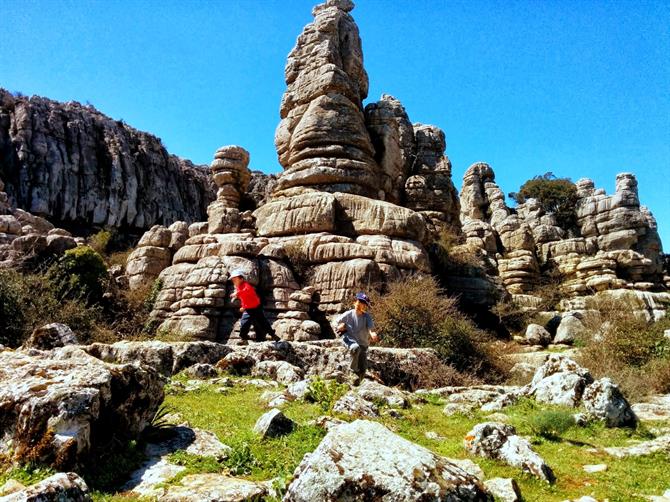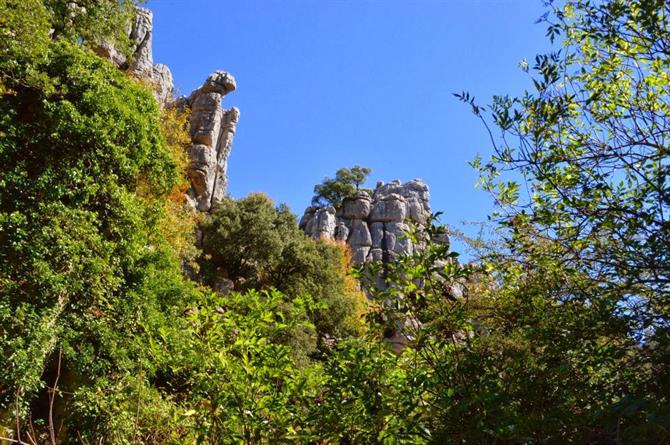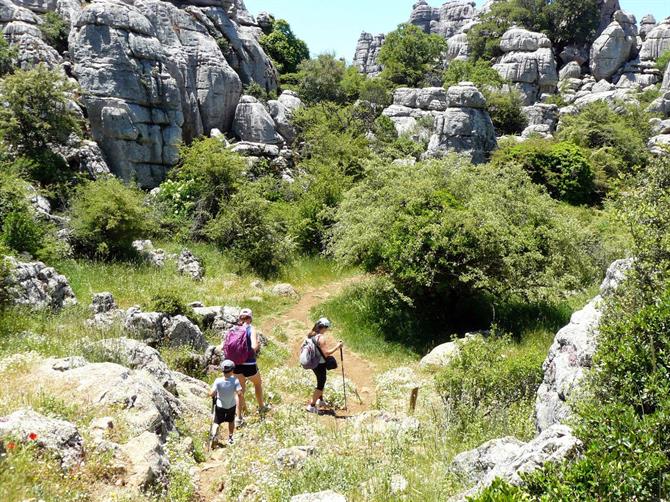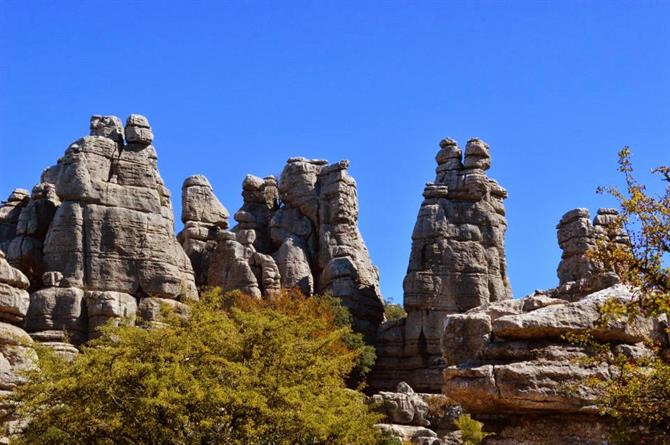The El Torcal Natural Reserve, el Paraje Natural de El Torcal, is the most geologically stunning of all of Andalucia’s natural parks. Renowned for its unique limestone formations, it has a surreal, almost eerie feel to it.
The whole area was under the Tetis sea some 150 million years ago. Violent Earth crust movements forced the seabed upwards into hills and mountains, a couple of which, are just over 1300m (the highest being the Camorro de las Siete Mesas at 1336m.) This was followed by millions of years of wind and rain erosion that has produced some of the most spectacular limestone scenery found anywhere in Europe.
Click on the interactive Photosphere above for a full 360° view.
About El Torcal Natural Reserve
The El Torcal Natural Reserve is situated approximately 45kms north of Malaga and only 13kms south of Antequera.
The nearest village is called Villanueva de la Concepción. In 1929, it was declared as a Nature Site of National Interest and in October of 1978, the Torcal was classified as a National Park and had its official borders registered. In 1989, the Junta de Andalucia finally acquired total control of the land and the Torcal was reclassified as a National Nature Reserve.
The reserve is home to some of the most striking karst formations in Europe. El Torcal owes its unique appearance due to the simultaneous working of various factors. One of the most important is the nature of the limestone rock itself.
The stone that makes up the Torcal belongs to a series of marine sedimentary rock that dates from the Mesozoic age and is comprised mainly of carbonate. Being particularly porous and soluble, the carbonate-rich limestone rock dissolves easily in El Torcal’s unique microclimate.
Being higher up, the Sierra de Torcal receives more rainfall than surrounding areas. Coupled with the porous nature of the surrounding limestone rock, makes the region a ‘perfect reservoir’ with underground rivers and a high watertable. The source of one of Antequera’s most important rivers - Rio La Villa is just at the base of the Sierra de la Torcal.
The human influence on El Torcal
Humans have been inhabiting the area since around 5500BC. From the Homo Neanderthals up to the Homo Sapiens.
The earliest evidence of human occupation is to be found in and around the Cueva del Toro. The various cave paintings, the remains at the Cancha de la Gotera and the human remains that have been found in various earth deposits, all point to a fairly permanent settlement during the Chalcolithic period - the period in which metals first appeared. This particular part of the Megalithic age is of specific importance to Antequera, coinciding with the building of the Dolmenes.

The Romans left their mark by constructing many of the roads that lead to the mountain range. Remains of which, are still visible today around the Boca del Asno and the Puerto de las Escanuelas. The Boca del Asno pass also played a particularly important part in later history during the battles between the Moors and Christians.
Flora and Fauna
Despite the harsh conditions and being at a relatively high altitude, the reserve has a large array of flora and fauna. Some endemic to the Torcal mountain range. Interspaced amongst the karst formations are lush almost tropical-like valleys full of vegetation and brimming with life.
Walking through them is an unforgettable experience. You walk through tunnels of vegetation in an almost prehistoric setting. Children, in particular, will have the time of their lives. Every corner you turn, is an assault on the senses. The landscape, the vegetation, the sounds and smells will have you begging for more.

El Torcal is an authentic floral paradise. Springtime is a fantastic time of year to visit the Torcal reserve. Its awash with wild flowers and brimming with life. The orchids, are of note, with over 30 species that have so far been identified. Wild rose bushes and various kinds of bramble create these seemingly vertical gardens across the rock faces.
As you walk through the park, keep your eyes upwards. Bird-lovers are more than spoilt for choice. It is home to various raptors, including Griffon vultures and Golden eagles. They are often seen circling high above the landscape scanning the horizons for their next meal.

El Torcal makes an ideal habitat for numerous reptiles. Two of which are endemic to the natural park. The Montpelier Snake and the Eyed Lizard. The Montpelier snake can grow up to two metres in length! The largest and most visible mammal population is without a doubt, that of the Ibex, the wild Iberian mountain goats. They seem to be everywhere. Watching you from every peak.
Flora - Quercus Ilex (the evergreen oak, holm oak or holly oak), Prunus Spinosa (Blackthorn), Pistacia Lentiscus (perennial bush or tree), Quercus Coccifera (kearnes oak), Crataegus Monogyna (Hawthorn), Rubus Ulmifolius Schott (blackberry), Rhamnus alaternus (buckthorn), Euphorbia characias (bush soft stems).
Mammals - Shrews, Rabbits, Least weasels, Fox, Hedgehogs, Garden mice, wildcats, Iberian Ibex, Badgers, Genets
Birds - Crested larks, Robins, Bee-eaters, Golden eagles, Griffon Vultures, Blackbirds, Blue Rock Thrush, Song Thrush, Wheatear, Warbler, Shrike
El Torcal's visitors centre
The Centro de Recepción, the visitor's centre, will be the starting point of any visit to the park. The large visitor’s centre has a restaurant, an exhibition hall that displays a few fossils and has regular audiovisual presentations explaining the local geology, flora and fauna.
There is also a small shop that sells maps, books and souvenirs. The maps are useful if planning to explore the area on your own. Although the set routes are well signposted, its a good idea to pick one up. Many of the karst formations have been given names, the knight, the thumb, the camel, the sphinx, the castle etc according to their appearance. The screw, El Tornillo is actually a protected natural monument. Children will have a lot of fun spotting and identifying them.

There are three set routes through the reserve. A green, yellow and red one. In order to protect the flora and fauna the red route (4.5kms) is in a restricted zone and can only be visited with a guide (at the time of writing). Information on guides is provided from the visitor’s centre.
The green and yellow routes are open to all and can be walked without a guide. The green route is the easiest, 1.5kms and takes about 30 minutes to complete. The yellow route mirrors the green and then divides off mid-way and passes through some spectacular parts of the park. Rocky labyrinths, that are filled with vegetation. The yellow route is 3kms in total. Both of the routes are circular and finish back at the visitor’s centre and a viewing point called ‘Mirador Las Ventanillas,’ the windows. A spot that offers some fantastic views over the surrounding countryside and on a clear day back to the Costa del Sol and across to North Africa.
By following one of the little paths that leads off from the mirador Las Ventanillas, one suggested spot to visit is in an area known as the ‘Ammonites,’ there are some fantastic fossils.

A word of warning, do not deviate from the set paths. It is very easy to get lost and disorientated in El Torcal. Its something that happens quite often and occasionally ends with tragic results. Under no circumstances enter the caves on your own accord. The green and yellow routes are well marked. Stay on them.
The best times to visit El Torcal are during the Spring and Autumn months. Temperatures can be extreme in winter and summer.
Astronomical Observatory Torcal
The Astronomical Observatory Torcal (Observatorio Astronómico del Torcal (O.A.T.)) sits adjacent to the visitor’s centre. It houses some very powerful telescopes, lasers and even specialised sun telescopes. Best of all, this advanced astrological centre is open to the public. They run various courses and have regular "A window to the Universe" evenings.
The lack of light pollution and the high altitude (1200m) combine to give some unbeatable night skies. There are special astrological viewing nights. The events feature stars, planets, different universes and various moon phases. An unforgettable experience.
During the Spring and Summer months they tend to take place every couple of weeks on Saturday nights. You need to register first. Its best to do so by sending an email to inscripciones@astrotorcal.es and leave your mobile number. Weather conditions can and do change very quickly in El Torcal - they’ll give you a call beforehand and let you know if they do. It will save a wasted trip up there. For more information visit the website of Astro Torcal or call +34600703700 (only Spanish is spoken).
Prices vary, but tend to be around 8€ per adult and 6€ for children/pensioners. The guided viewing sessions last for about two hours. The day time solar viewing normally take place on Sunday afternoons. Once again, its best to check the website for further information.
How get to El Torcal
If coming from the Costa del Sol/Malaga direction, the best way to get to El Torcal is via Villanueva de la Concepción. You can drive into the centre of Antequera and work your way upwards on the MA-9016, although a very scenic route, it takes longer.
Centro de Visitantes del Torcal de Antequera
Paraje Natural Torcal de Antequera
Ctra. 7075 s/n
29200 Antequera,
Málaga, Spain
Website - torcaldeantequera.com
Tel. +34 952 24 33 24
